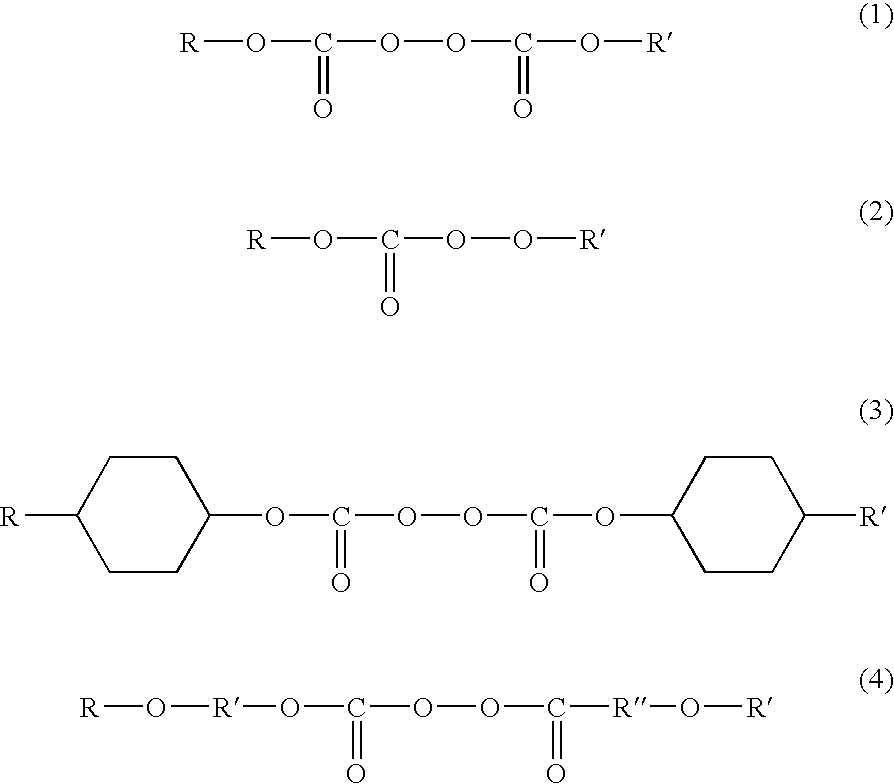Fluorochemical adhesive material and laminate comprising the same
- Summary
- Abstract
- Description
- Claims
- Application Information
AI Technical Summary
Benefits of technology
Problems solved by technology
Method used
Image
Examples
synthesis example 1
Synthesis of a Fluorine-containing Polymer Having a Carbonate Group
200 L of pure water was charged into a glass-lined autoclave having an internal volume of 820 L and an internal atmosphere of the autoclave was sufficiently replaced with a nitrogen gas. After vacuuming, 113 kg of 1-fluoro-1,1-dichloroethane, 95 kg of hexafluoropropylene and 85 kg of cyclohexane were charged therein. Then, 292 g of perfluoro(1,1,5-trihydro-1-pentene) represented by the formula (iii):
CH.sub.2.dbd.CF(CF.sub.2).sub.3 H (iii)
was injected with a nitrogen gas to give a pressure of 7.25 kg / cm.sup.2 G. Then, ethylene was injected to give a pressure of 8 kg / cm.sup.2 G.
Then, 1.9 kg of a 50% solution of di-n-propylperoxydicarbonate in methanol was charged to initiate a polymerization. Since a pressure in the reactor was lowered as the polymerization proceeded, a mixture gas of tetrafluoroethylene / ethylene / hexafluoropropylene (molar ratio=39.2:43.6:17.3) was additionally injected therein to maintain the pressure...
synthesis example 2
Synthesis of a Fluorine-containing Polymer Having a Carbonate Group
400 L of pure water was charged to a 1,000 L stainless autoclave, the interior of the autoclave was sufficiently substituted with a nitrogen gas. After vacuuming, 262 kg of perfluorocyclobutane was charged. Then, 2.36 kg of perfluoro(1,1,5-trihydro-1-pentene) of the formula (iii) was injected therein using a nitrogen gas and a temperature of the interior of the autoclave and a stirring speed were maintained at 20.degree. C. and 180 rpm, respectively.
Tetrafluoroethylene was injected to give a pressure of 8.57 kg / cm.sup.2 G and then ethylene was injected to give a pressure of 9.13 kg / cm.sup.2 G. Then, the internal temperature and pressure of the autoclave were brought to 35.degree. C. and 12 kg / cm.sup.2 G, respectively.
Then, 2.3 kg of a 50% solution of di-n-propylperoxydicarbonate in methanol was charged to initiate a polymerization reaction. Since an internal pressure of the autoclave was lowered as the polymerization...
synthesis example 3
Synthesis of a Fluorine-containing Polymer Having a Carbonate Group and a Carboxylic Acid Fluoride Group
The powder obtained in Synthesis Example 1 was charged in an single axial extruder (VS 50-24 manufactured by Tanabe Plastic Kikai K.K.) (L / D=24) (screw diameter: 50 mm), and extruded at a cylinder temperature of from 300.degree. C. to 320.degree. C. and a resin temperature near die of 320.degree. C. to give pellets. The physical properties of the resultant polymer are shown in Table 1.
PUM
| Property | Measurement | Unit |
|---|---|---|
| Angle | aaaaa | aaaaa |
| Angle | aaaaa | aaaaa |
| Angle | aaaaa | aaaaa |
Abstract
Description
Claims
Application Information
 Login to View More
Login to View More - Generate Ideas
- Intellectual Property
- Life Sciences
- Materials
- Tech Scout
- Unparalleled Data Quality
- Higher Quality Content
- 60% Fewer Hallucinations
Browse by: Latest US Patents, China's latest patents, Technical Efficacy Thesaurus, Application Domain, Technology Topic, Popular Technical Reports.
© 2025 PatSnap. All rights reserved.Legal|Privacy policy|Modern Slavery Act Transparency Statement|Sitemap|About US| Contact US: help@patsnap.com

